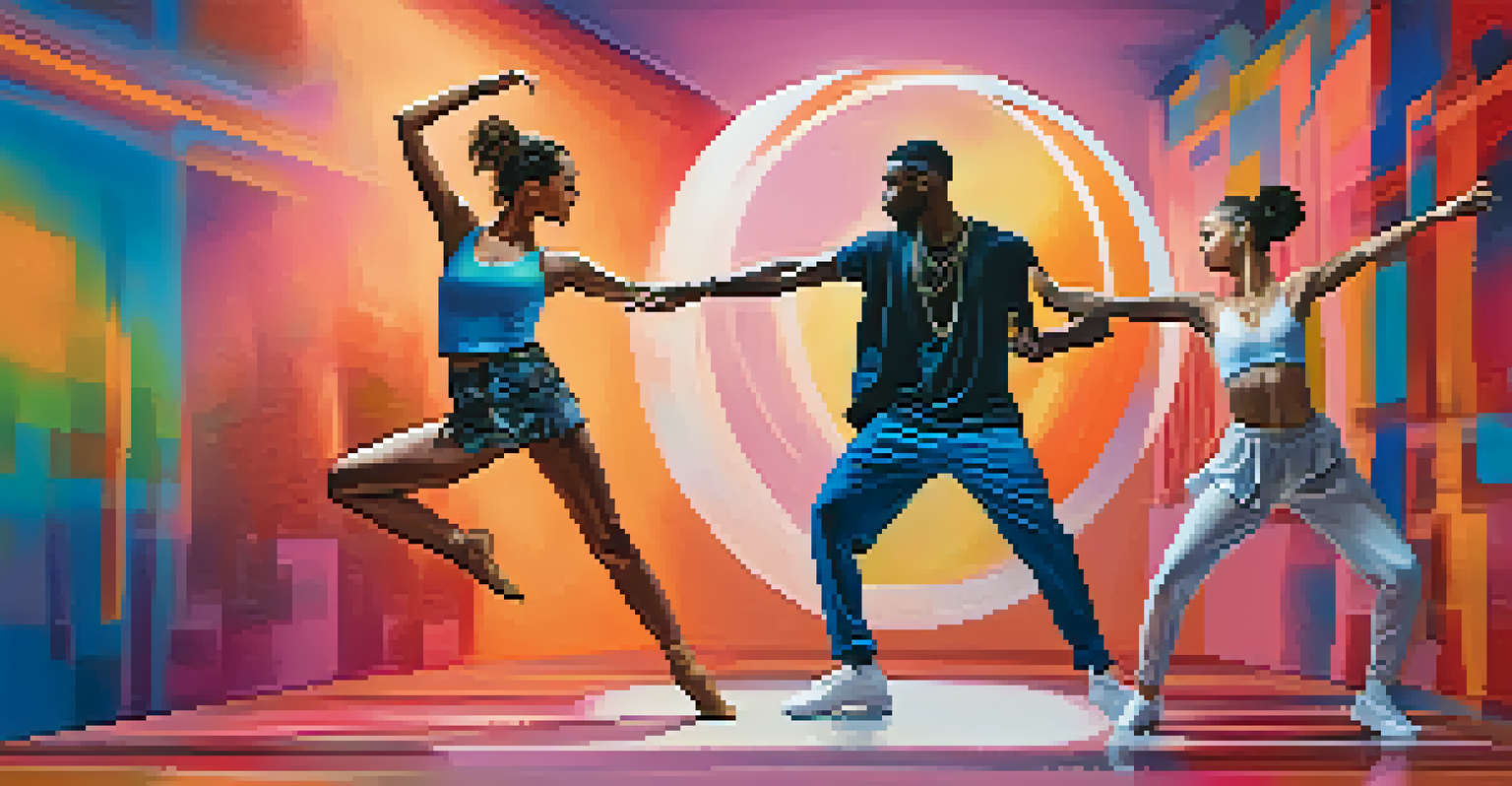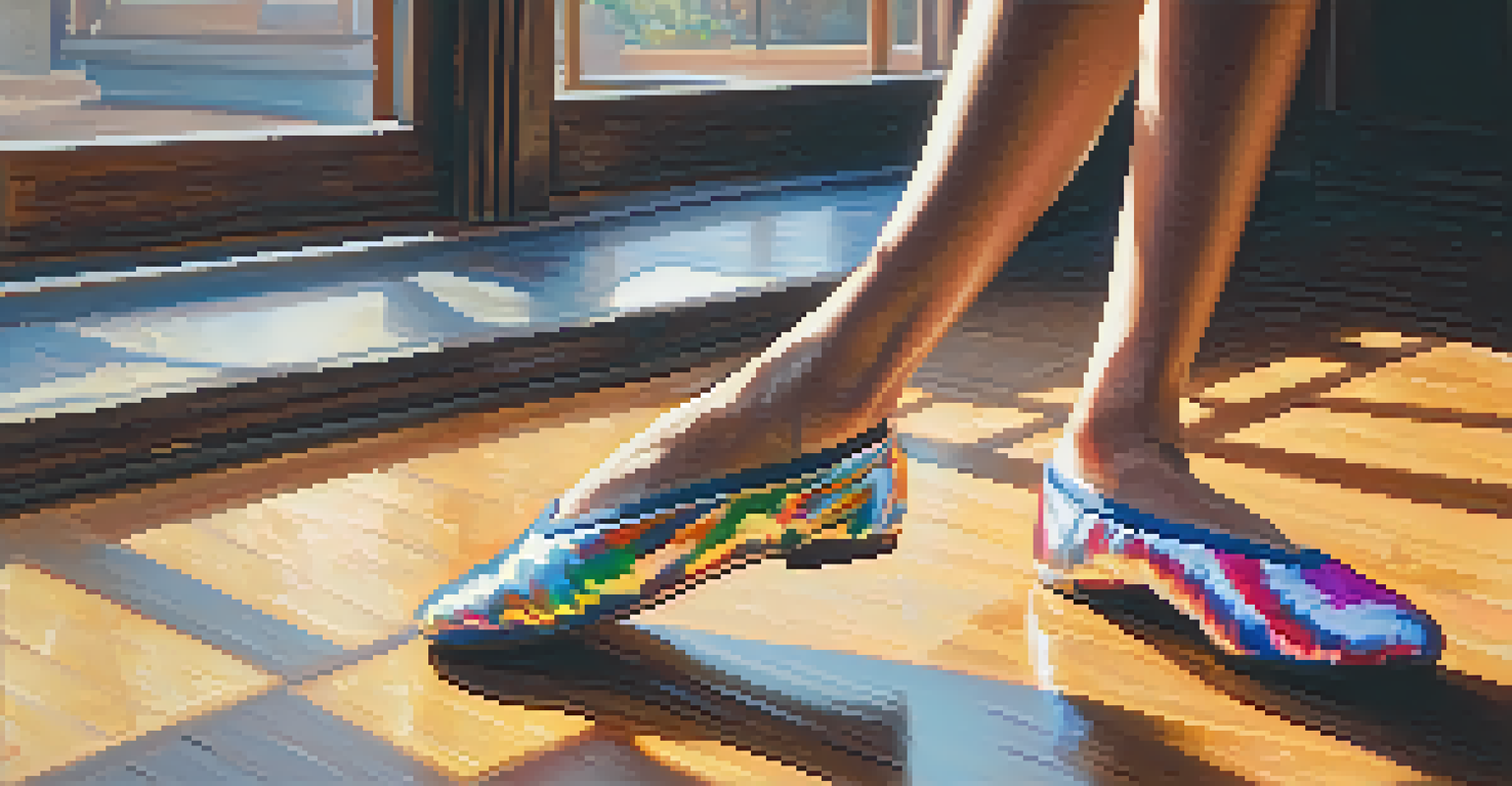Digital Platforms: Connecting Dancers Worldwide in Real-Time

The Rise of Digital Platforms for Dancers
In recent years, digital platforms have transformed the way dancers connect and collaborate. No longer limited by geography, dancers can now share their passion and skills with others around the world at the click of a button. Platforms like Zoom, Instagram, and TikTok have made it easy for dancers to showcase their talent and learn from one another in real-time.
Dance is the hidden language of the soul.
These platforms foster a sense of community among dancers, regardless of their location. Whether it's a casual jam session or a structured dance class, the possibilities for connection are endless. Dancers can join virtual workshops, participate in challenges, and even compete in online competitions—all from the comfort of their own homes.
This digital revolution has made dance more accessible than ever. Aspiring dancers from underrepresented regions can now find mentors, resources, and opportunities that were once out of reach. The democratization of dance education is truly changing the landscape of this art form.
Benefits of Real-Time Connection for Dancers
The ability to connect in real-time offers numerous advantages for dancers seeking growth and inspiration. Instant feedback from peers and instructors can enhance learning, allowing dancers to correct mistakes and refine their techniques on the spot. This immediate interaction creates a vibrant learning environment that traditional classes might lack.

Moreover, real-time connections foster collaboration among dancers from different backgrounds and styles. Imagine a hip-hop dancer teaming up with a ballet dancer to create a unique fusion routine—this type of collaboration is made possible through digital platforms. As dancers share their diverse skills, they push each other to innovate and break boundaries.
Digital Platforms Unite Dancers
Dancers can now connect globally, share skills, and collaborate through platforms like Zoom and TikTok.
Additionally, the sense of camaraderie built through these interactions can be incredibly motivating. Dancers can support and encourage one another, making the journey feel less isolating. This shared experience not only enhances individual skills but also nurtures a global dance community.
Embracing Diversity Through Digital Platforms
One of the most exciting aspects of digital platforms is their ability to celebrate diversity in dance. Dancers from various cultures and backgrounds can share their unique styles and traditions, enriching the global dance scene. This cross-pollination of ideas can lead to innovative choreography and fresh perspectives on movement.
We all have the ability to dance; it’s just that some of us are too afraid to let it out.
For instance, a dancer from Brazil can introduce their samba techniques to a dancer in Japan, sparking creativity and collaboration. This cultural exchange not only broadens individual skill sets but also fosters respect and appreciation for different dance forms. It creates a tapestry of movement that reflects the beauty of global diversity.
Furthermore, digital platforms can help preserve traditional dance forms that might be at risk of fading. By recording and sharing these dances, dancers can document their heritage and ensure that future generations can learn and appreciate their cultural roots.
Challenges of Online Dance Interaction
While digital platforms offer incredible opportunities, they also come with their fair share of challenges. Technical issues such as connectivity problems can disrupt classes or performances, leaving dancers frustrated. It's essential for both instructors and participants to have a reliable internet connection to fully benefit from these online experiences.
Moreover, the lack of physical presence can hinder certain aspects of learning, particularly in styles that require close observation and correction. Dancers might struggle to grasp nuances in technique without the tactile feedback that a live instructor can provide. This might lead some to feel less motivated in an online setting.
Real-Time Interaction Enhances Learning
Instant feedback and collaboration in virtual settings allow dancers to refine their techniques and innovate.
Finally, the overwhelming amount of content available on digital platforms can be both a blessing and a curse. Dancers might find it difficult to sift through countless videos and tutorials to find quality instruction that aligns with their goals. It's important for dancers to curate their learning experience and focus on resources that resonate with them.
The Role of Social Media in Dance Connection
Social media has played a pivotal role in connecting dancers worldwide. Platforms like Instagram and TikTok allow dancers to showcase their skills and creativity to a global audience, often leading to opportunities that may not have been available otherwise. The power of hashtags can connect dancers with similar interests, creating a virtual community at their fingertips.
Moreover, social media serves as a platform for dancers to share their journeys, challenges, and successes. This transparency can inspire others facing similar obstacles, fostering a sense of solidarity within the dance community. Dancers can follow their idols and learn from their experiences, bridging the gap between seasoned professionals and novices.
However, it's important for dancers to maintain a healthy relationship with social media. While it can be a valuable tool for connection and inspiration, it can also lead to comparison and self-doubt. Dancers should focus on their personal growth rather than getting caught up in the highlight reels of others.
Future Trends in Digital Dance Platforms
As technology continues to evolve, so too will digital platforms designed for dancers. Virtual reality (VR) and augmented reality (AR) are on the horizon, promising to create even more immersive experiences for learning and collaboration. Imagine dancing alongside someone halfway across the world in a virtual studio—all while feeling their presence as if they were right next to you.
Additionally, artificial intelligence (AI) is likely to play a role in personalized dance education. AI could analyze a dancer's movements and provide tailored feedback, helping them improve at their own pace. This kind of individualized instruction could revolutionize how dancers learn online, making it more effective and engaging.
Diversity Enriches Dance Communities
Digital platforms celebrate cultural exchange, allowing dancers to learn from diverse styles and preserve traditional forms.
Finally, we can expect an increase in the availability of hybrid classes that combine in-person and online elements. This approach allows dancers to enjoy the best of both worlds, offering flexibility while maintaining the benefits of face-to-face interaction. The future of dance is looking bright, and digital platforms will undoubtedly play a crucial role in shaping it.
Creating a Supportive Digital Dance Community
Building a supportive community within digital platforms is essential for fostering growth and connection among dancers. Online forums, social media groups, and virtual events can help dancers engage with one another, share advice, and celebrate achievements. This sense of belonging encourages dancers to stay committed to their craft, even amidst challenges.
Instructors and experienced dancers can play a vital role in nurturing this community by offering guidance and mentorship. By sharing their knowledge and experiences, they can uplift newcomers and help them navigate the sometimes overwhelming world of dance. This mentorship can bridge the gap between different skill levels, creating a more inclusive environment.

Ultimately, a supportive digital dance community can lead to lasting friendships and collaborations. As dancers connect on a personal level, they can inspire one another to push their boundaries and explore new styles. Together, they can cultivate a vibrant ecosystem that celebrates creativity and passion for dance.